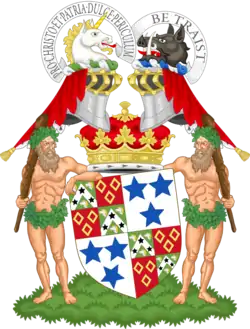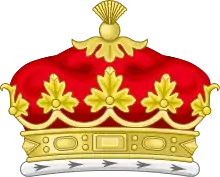Duke of Roxburghe
The Duke of Roxburghe (/ˈrɒksbərə/) is a title in the peerage of Scotland created in 1707 along with the titles Marquess of Bowmont and Cessford, Earl of Kelso and Viscount Broxmouth. John Ker, 5th Earl of Roxburghe became the first holder of these titles. The title is derived from the royal burgh of Roxburgh in the Scottish Borders that in 1460 the Scots captured and destroyed.
| Dukedom of Roxburghe | |
|---|---|
 Quarterly, 1st and 4th grandquarters: quarterly, 1st and 4th, Vert on a Chevron between three Unicorns' Heads erased Argent armed and maned Or as many Mullets Sable (Ker); 2nd and 3rd, Gules three Mascles Or (Weepont); 2nd and 3rd grandquarters: Argent three Stars of five points Azure (Innes). | |
| Creation date | 1707 |
| Monarch | Anne |
| Peerage | Peerage of Scotland |
| First holder | John Ker, 5th Earl of Roxburghe |
| Present holder | Charles Innes-Ker, 11th Duke |
| Heir presumptive | Lord Edward Arthur Gerald Innes-Ker |
| Remainder to | the heirs inheriting the Earldom of Roxburghe (see that section for details) |
| Subsidiary titles | Marquess of Bowmont and Cessford Earl of Roxburghe Earl of Kelso Earl Innes Viscount Broxmouth Lord Roxburghe Lord Ker of Cessford and Cavertoun |
| Seat(s) | Floors Castle |

Originally created Earl of Roxburghe in 1616, before the elevation to duke, a number of other subsidiary titles are held: Marquess of Bowmont and Cessford (created 1707), Earl of Kelso (1707), Earl Innes (1837), Viscount Broxmouth (1707), Lord Roxburghe (1600), and Lord Ker of Cessford and Cavertoun (1616). All of the titles form part of the peerage of Scotland, with the exception the Earldom of Innes, which belongs to the peerage of the United Kingdom. The Duke's eldest son bears the courtesy title of Marquess of Bowmont and Cessford.
The dukedom and its associated titles descend to heirs who shall inherit the earldom which in turn had a very specific line of descent. On the death of the 4th duke the titles became dormant as no one could prove their claim. In 1812 the House of Lords ruled in favour of Sir James Innes-Ker, 6th Baronet, of Innes (see Innes baronets), rejecting claims by the heir female of the second earl and heir male whatsoever of the first earl.
The Duke of Roxburghe would be the Chief of Clan Innes, but cannot be so recognised as he retains the name Innes-Ker.[1]
The family has its seat at Floors Castle near Kelso, Scotland. The grounds contain the ruins of Roxburgh Castle on a promontory between the rivers Tweed and Teviot. The traditional burial place of the Dukes of Roxburghe is the Roxburghe Memorial Cloister (also known as "Roxburghe Aisle"), a 20th-century addition to the ruins of Kelso Abbey.
Earls of Roxburghe (1616)
In 1600, Robert Ker was created Lord Roxburghe, in 1616 he was additionally created Earl of Roxburghe, and Lord Ker of Cessford and Cavertoun. The succession was originally to heirs male of the 1st Earl, but after his sons predeceased him, the title was recreated in 1646 with additional remainder in favour of "(i) his grandson by his eldest daughter, Sir William Drummond, and his issue in tail male, (ii) of his great-grandsons in like manner, i.e. the second and other younger sons of Jane Drummond, the sister of Sir William Drummond, by her husband John [Fleming], 3rd Earl of Wigtown [...] which failing (iii) of the eldest daughter of Hon Harry Ker, styled Lord Ker, without division and to her heirs male, which failing (iv) to his own heirs male whomsoever".
- Robert Ker, 1st Earl of Roxburghe (1570–1650) had been Lord Roxburghe since 1600, died without male issue
- William Ker, Lord Ker (died 1618), elder son of the 1st Earl, predeceased his father without issue
- Henry Ker, Lord Ker (died 1643), younger son of the 1st Earl, predeceased his father without male issue
- William Ker, 2nd Earl of Roxburghe (1622–1675), a female-line grandson of the 1st Earl, succeeded him by the above special arrangement
- Robert Ker, 3rd Earl of Roxburghe (c. 1658–1682), eldest son of the 2nd Earl
- Robert Ker, 4th Earl of Roxburghe (c. 1677–1696), eldest son of the 3rd Earl
- John Ker, 5th Earl of Roxburghe (c. 1680–1741), second son of the 3rd Earl, became Duke of Roxburghe in 1707
Dukes of Roxburghe (1707)
- John Ker, 1st Duke of Roxburghe (c. 1680–1741), second son of the 3rd Earl, he was additionally invested as Marquess of Bowmont and Cessford as well as Earl of Kelso and Viscount Broxmouth in 1707; the earlier titles held as Earl were also retained
- Robert Ker, 2nd Duke of Roxburghe (c. 1709–1755), only son of the 1st Duke, in 1722 he was created both Earl Ker and Baron Ker of Wakefield in the County of York
- John Ker, 3rd Duke of Roxburghe (1740–1804), elder son of the 2nd Duke inheriting the 1722 titles, died without issue
- William Bellenden-Ker, 4th Duke of Roxburghe (1728–1805), grandson of Lord Bellenden of Broughton (created 1661) who was the fourth and youngest son of the 2nd Earl, died without issue and the Roxburghe titles went dormant until 1812
- James Innes-Ker, 5th Duke of Roxburghe (1736–1823), great-grandson of Hon. Margaret Ker (died 1681), daughter of Hon. Henry Ker, Lord Ker (died 1642/3), the younger son of the 1st Earl
- James Innes-Ker, 6th Duke of Roxburghe (1816–1879), only son of the 5th Duke, he was created Earl Innes in the peerage of the United Kingdom in 1837
- James Henry Robert Innes-Ker, 7th Duke of Roxburghe (1839–1892), elder son of the 6th Duke
- Henry John Innes-Ker, 8th Duke of Roxburghe (1876–1932), eldest son of the 7th Duke
- George Victor Robert John Innes-Ker, 9th Duke of Roxburghe (1913–1974), only son of the 8th Duke
- Guy David Innes-Ker, 10th Duke of Roxburghe (1954–2019), elder son of the 9th Duke
- Charles Robert George Innes-Ker, 11th Duke of Roxburghe (born 1981), eldest son of the 10th Duke
The heir presumptive is the current holder's younger brother, Lord Edward Arthur Gerald "Ted" Innes-Ker (born 1984)
Line of Succession
 Robert Ker, 1st Earl of Roxburghe (1570-1650)
Robert Ker, 1st Earl of Roxburghe (1570-1650)
- William Ker, Lord Ker (died 1618)
- Lady Jean Ker
 William Ker, 2nd Earl of Roxburghe (1622–1675)
William Ker, 2nd Earl of Roxburghe (1622–1675)
 Robert Ker, 3rd Earl of Roxburghe (c. 1658–1682)
Robert Ker, 3rd Earl of Roxburghe (c. 1658–1682)
 Robert Ker, 4th Earl of Roxburghe (c. 1677–1696)
Robert Ker, 4th Earl of Roxburghe (c. 1677–1696) John Ker, 1st Duke of Roxburghe (c. 1680–1741)
John Ker, 1st Duke of Roxburghe (c. 1680–1741)
 Robert Ker, 2nd Duke of Roxburghe (c. 1709–1755)
Robert Ker, 2nd Duke of Roxburghe (c. 1709–1755)
 John Ker, 3rd Duke of Roxburghe (1740–1804)
John Ker, 3rd Duke of Roxburghe (1740–1804)
 John Bellenden, 2nd Lord Bellenden (died 1707)
John Bellenden, 2nd Lord Bellenden (died 1707)
 John Bellenden, 3rd Lord Bellenden (1685–1741)
John Bellenden, 3rd Lord Bellenden (1685–1741)
 Ker Bellenden, 4th Lord Bellenden (1725–1753)
Ker Bellenden, 4th Lord Bellenden (1725–1753)
 John Ker Bellenden, 5th Lord Bellenden (1751–1796)
John Ker Bellenden, 5th Lord Bellenden (1751–1796)
 Robert Bellenden, 6th Lord Bellenden (1734–1797)
Robert Bellenden, 6th Lord Bellenden (1734–1797)
- William Bellenden (1702-1758)
- Henry Ker, Lord Ker (died 1643)
- Margaret Ker (died 1681)
 Sir Henry Innes, 4th Baronet (died 1721)
Sir Henry Innes, 4th Baronet (died 1721)
 Sir Henry Innes, 5th Baronet (died 1762)
Sir Henry Innes, 5th Baronet (died 1762)
 James Innes-Ker, 5th Duke of Roxburghe (1736–1823)
James Innes-Ker, 5th Duke of Roxburghe (1736–1823)
 James Innes-Ker, 6th Duke of Roxburghe (1816-1879)
James Innes-Ker, 6th Duke of Roxburghe (1816-1879)
 James Innes-Ker, 7th Duke of Roxburghe (1839-1892)
James Innes-Ker, 7th Duke of Roxburghe (1839-1892)
 Henry Innes-Ker, 8th Duke of Roxburghe (1876-1932)
Henry Innes-Ker, 8th Duke of Roxburghe (1876-1932)
 George Innes-Ker, 9th Duke of Roxburghe (1913-1974)
George Innes-Ker, 9th Duke of Roxburghe (1913-1974)
 Guy Innes-Ker, 10th Duke of Roxburghe (1954-2019)
Guy Innes-Ker, 10th Duke of Roxburghe (1954-2019)
 Charles Innes-Ker, 11th Duke of Roxburghe (born 1981)
Charles Innes-Ker, 11th Duke of Roxburghe (born 1981)- (1) Lord Edward Innes-Ker (born 1984)
- (2) Lord George Innes-Ker (born 1996)
- (3) Lord Robin Innes-Ker (born 1959)
- (4) James Innes-Ker (born 1999)
- Margaret Ker (died 1681)
Family Tree
See also
- Clan Innes
- Roxburgh Castle
- Castle Holydean
- Earl of Perth
- Earl of Melfort
- An 1810 auction of the Duke's library is featured in Susanna Clarke's novel Jonathan Strange & Mr. Norrell
References
- "The Standing Council of Scottish Chiefs Requirements for Recognition". Archived from the original on 26 February 2012. Retrieved 3 September 2009.
- Acceded to the title of Lord Bellenton of Broughton as the 2nd Earl, inheriting the title from his kinsman, the 1st Earl, by special remainder under Royal Charter of 1673
External links
- Chisholm, Hugh, ed. (1911). . Encyclopædia Britannica. 23 (11th ed.). Cambridge University Press. p. 789.CS1 maint: ref=harv (link)
- http://www.stirnet.com/ (subscription only)